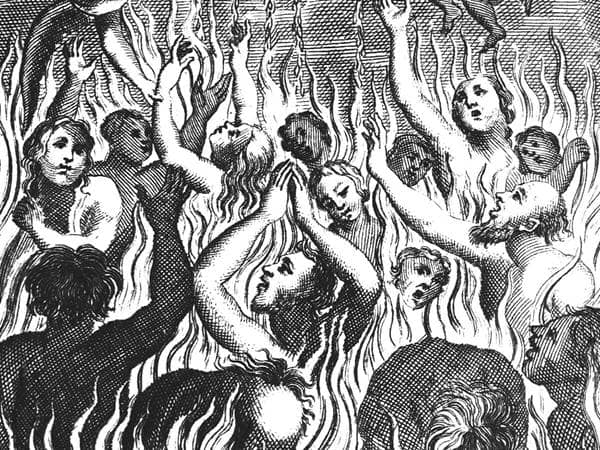
Misinterpretations of Biblical Texts on the Earth's Shape
Popular, even in ancient times, was the idea that the earth is flat—often understood to be a horizontal or level disk that floats in the ocean. While medieval Europeans commonly believed in a flat earth, ancient Mesopotamians and Egyptians believed this idea millennia before certain Christians embraced this theory. Though the ancients relied on texts (like the Coffin Texts or the Pyramid Texts) for their belief in a flat earth, many medieval Protestants saw evidence in the Bible for a flat earth view.
Because so much of the biblical text is laden in symbolism—symbols foreign to most modern societies—things understood by the ancients as symbolic are too often misinterpreted by moderns as literal. For example, numbers are often used in very symbolic ways in the Bible. The numbers one, three, four, six, seven, ten, twelve, etc., are each employed with symbolic intent in many biblical passages. The number seven is, by far, the most symbolically employed number in the Bible. While today, many see the number seven as symbolic of good luck, ancients saw it as a symbol of wholeness, completeness, and the like. Thus, when the Bible says that the earth was created in “seven days,” scholars of biblical symbolism typically understand that to be figurative, implying that (after an unspecified amount of time) the creation process was “completed” and the earth was “whole” or “wholly” finished. Thus, what was understood anciently as nothing more than a symbol has been read by some today as entirely literal; and, consequently, the text is often understood to be saying something other than what was originally intended.
As it relates to the “flat earth” theory, this too (for Christians) tends to stem from a misunderstanding of the biblical text and its very standard symbols. Phrases like the “ends of the earth,” the “four corners of the earth,” and the “pillars” of the earth, have caused some to assume that the earth is a flat surface, usually square in shape, and supported in the sky by unseen pillars on the bottom side of the planet.
In 1 Samuel 2:10 we are told that “the LORD shall judge the ends of the earth.” This phrase, “ends of the earth,” appears 27 times in the King James Version of the Old Testament, though only once in the New Testament—in Acts 13:47, where it states that God’s people should be “a light of the Gentiles…unto the ends of the earth.” (The Contemporary English Version words this as follows: God’s people should be “a light for the gentiles…to people everywhere on earth.”) The idea that God would “judge the ends of the earth” or that believers would bring “light” to “gentiles” living on “the ends of the earth” both serve as metaphors, suggesting that Jesus will judge everyone, no matter where (on earth) they are found; and believers should live exemplary lives that could bless all unbelieving people, no matter where on earth that they live. In other words, to “the ends of the earth” is hyperbole, and simply means “all people everywhere.” Anciently, “ends of the earth” did not carry the connotation that the earth had “ends,” corners, or a square and flat shape. What it meant was that every inch was known by God and was constantly under His view (or awareness). The phrase is simply a superlative that means “everyone everywhere.”
Several times in the Bible it uses the number four in a symbolic way. Isaiah speaks of gathering Judah “from the four corners of the earth.” (KJV Isaiah 11:12) Similarly, in the Book of Revelation, John also speaks of “the four corners of the earth.” (KJV Revelation 7:1) The Book of Job speaks of a curse which “smote the four corners of the house.” (KJV Job 1:19) The number four was an ancient symbol of “geographic fullness” or “totality,” and typically represented something that applied to or affected the entire earth and everyone on it. It didn’t in any way imply that the earth was square or flat. Only that what Isaiah, John, and Job were seeing would affect everyone (living on the earth or dwelling on Job’s house). While the idea of the earth having “four corners” has probably been the biggest reason why some think that the Bible teaches that the earth is flat, there is one additional reason some see in the biblical text evidence for a flat earth.
The idea of an earth that rests on “pillars” appears several times in the Bible. For example, in the 75th Psalm, we read of “the pillars” of the “earth.” (KJV Psalm 75:3) In the Book of 1 Samuel, we are informed that “the pillars of the earth are the LORD'S, and he hath set the world upon them.” (KJV 1 Samuel 2:8) Similarly, the Book of Job speaks of God shaking “the earth out of her place, and the pillars thereof tremble.” (KJV Job 9:6) Pillars were ancient symbols of support. The notion that the earth “rests” on “pillars” was a metaphor that meant that God supports the earth He created. This ancient metaphor did not mean that God had literally set the earth on top of something. It simply symbolizes the idea that God is the one who, in all ways, supports the earth and those that dwell on it. He supports it by causing the earth to grow and produce what’s needed to sustain life. He supports it in that He grants us life and our ability to move and to act. He supports it in that He has a plan for the earth and its inhabitants. Thus, the ancients would not have used this phrase to imply literal pillars on which a flat earth rests. Rather, their point was that the God who created this earth also supports life on it.
There is no question, a literal reading of the Bible could give one the impression that it teaches a flat earth theory. However, in every single case, the passages used to “prove” a flat earth theory are verses that were common metaphors in antiquity, meaning something very different from what a literal reading of the text would imply. Thus, while the Bible can be misinterpreted to support a flat earth, it never actually teachings that scientifically disproven theory.
Bible Verses about Earth's Shape
- 1 Samuel 2:10 - "The adversaries of the LORD shall be broken to pieces; out of heaven shall he thunder upon them: the LORD shall judge the ends of the earth; and he shall give strength unto his king, and exalt the horn of his anointed."
- Acts 13:47 - "For so hath the Lord commanded us, saying, I have set thee to be a light of the Gentiles, that thou shouldest be for salvation unto the ends of the earth."
- Isaiah 11:12 - "And he shall set up an ensign for the nations, and shall assemble the outcasts of Israel, and gather together the dispersed of Judah from the four corners of the earth."
- Revelation 7:1 - "And after these things I saw four angels standing on the four corners of the earth, holding the four winds of the earth, that the wind should not blow on the earth, nor on the sea, nor on any tree."
- Job 1:19 - "And, behold, there came a great wind from the wilderness, and smote the four corners of the house, and it fell upon the young men, and they are dead; and I only am escaped alone to tell thee."
- Psalm 75:3 - "The earth and all the inhabitants thereof are dissolved: I bear up the pillars of it. Selah."
- 1 Samuel 2:8 - "He raiseth up the poor out of the dust, and lifteth up the beggar from the dunghill, to set them among princes, and to make them inherit the throne of glory: for the pillars of the earth are the LORD'S, and he hath set the world upon them."
- Job 9:6 - "Which shaketh the earth out of her place, and the pillars thereof tremble."
4/1/2024 7:31:39 PM

















